
The fourragère is a military award, distinguishing military units as a whole, in the form of a braided cord. The award was first adopted by France, followed by other nations such as the Netherlands, Belgium, Portugal, and Luxembourg. Fourragères have been awarded to units of both national and foreign militaries, except for that of Luxembourg, which has not been awarded to any foreign units.

The 2nd Foreign Parachute Regiment is the only airborne regiment of the Foreign Legion in the French Army. It is one of the four infantry regiments of the 11th Parachute Brigade and part of the spearhead of the French rapid reaction force.

The 1st Foreign Engineer Regiment is one of two combat engineer regiments of the Foreign Legion in the French Army. The regiment provides the combat engineering component of the 6th Light Armoured Brigade.

The 2nd Foreign Engineer Regiment is one of two combat engineer regiments of the Foreign Legion in the French Army. Stationed, since its creation in 1999, on the former site of the French Strategic Nuclear Missiles at Saint Christol, Vaucluse, southern France. The regiment provides the combat engineering component of the 27th Mountain Infantry Brigade.
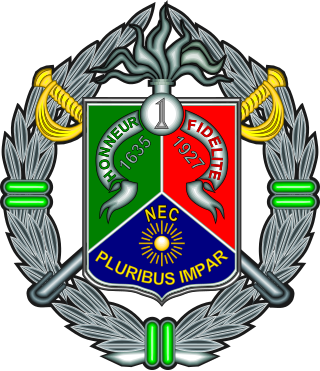
The 1st Foreign Cavalry Regiment is the only cavalry regiment of the Foreign Legion in the French Army. It is one of two armoured cavalry regiments of the 6th Light Armoured Brigade.

The 6th Marine Infantry Parachute Regiment is an airborne infantry unit of the French Army.
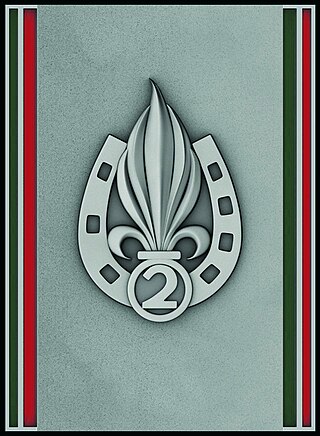
The 2nd Foreign Infantry Regiment is an infantry regiment of the Foreign Legion in the French Army. The regiment is one of two mechanized infantry regiments of the 6th Light Armoured Brigade.

The Régiment d'infanterie chars de marine in French, is a light cavalry regiment of the French Army, successor to the Régiment d'infanterie coloniale du Maroc.
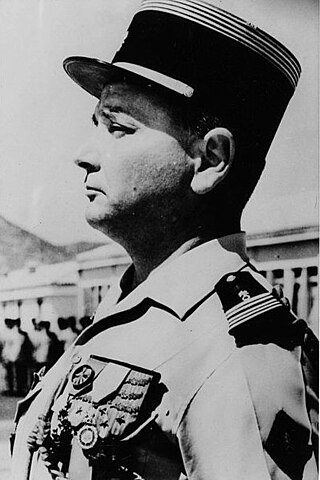
Paul Marie Félix Jacques René Arnaud de Foïard was a général in the French Army who served primarily in the French Foreign Legion taking part in World War II and the conflicts of Indochina and Algeria.

Bruno Dary is a former Général d'armée of the French Army and commandant of the Foreign Legion. He was the 136th Military governor of Paris from 1 August 2007 until 2012, and is the current President of the Committee of the Flame under the Arc de Triomphe de l'Étoile, the association in charge of maintaining the eternal flame of the Tomb of the Unknown Soldier.

Benoît Puga is a general in the French Army and the Grand Chancellor of the National Order of the Legion of Honour and the National Order of Merit.

The 1st Parachute Chasseur Regiment is the oldest and among the most decorated Airborne forces regiments of the French Army. Established in the French Army in 1943 and formerly part of the French Air Force since 1937, the chasseur distinguished its Regimental Colors during the campaigns of the Liberation of Paris, the First Indochina War in 1947, 1950, 1953, 1954 and the Algerian War. This elite regiment is part of the 11th Parachute Brigade.

The 11th Marine Artillery Regiment (France) (French: 11e Régiment d'Artillerie de Marine, 11e RAMa) is an artillery regiment of the French Army. The regiment constitutes the fire support unit of the 9th Marine Infantry Brigade. The regiment employs around 950 men, fielding TRF1 155mm howitzers and MO-120-RT-61 120mm mortars. The regiment was founded in a third operational phase in 1951.
Jeannou Lacaze, was a French Général d'armée of the French Army and Chef d'État-Major des armées (1981-1985), who also served in the French Foreign Legion.

Bernard Janvier is a former general of the French Army who served in the French Foreign Legion, primarily spearheading and putting in place effective resolving forces.
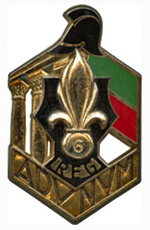
The 6th Foreign Engineer Regiment was a unit of the Foreign Legion in the French Army, part of the rapid reaction force and component of the 6th Light Armoured Division,. The 6th Foreign Engineer Regiment became the 1st Foreign Engineer Regiment in 1999.
Jacques Lefort was a Général de corps d'armée of the French Army and Commandant of the Foreign Legion.
Bernard Grail is a Général of the French Army and a former Commandant of the Foreign Legion (COMLE).
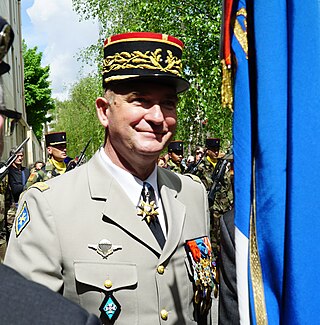
Éric Bellot des Minières is an army general of the French Army. He has been Inspector General of the French Armed Forces since October 31, 2020.
Maurice Schmitt, is a French general and chief of the general staff headquarters of the Armies (CEMA) from 16 November 1987 until 23 April 1991. He was then appointed as Governor of Les Invalides until 1996.
















